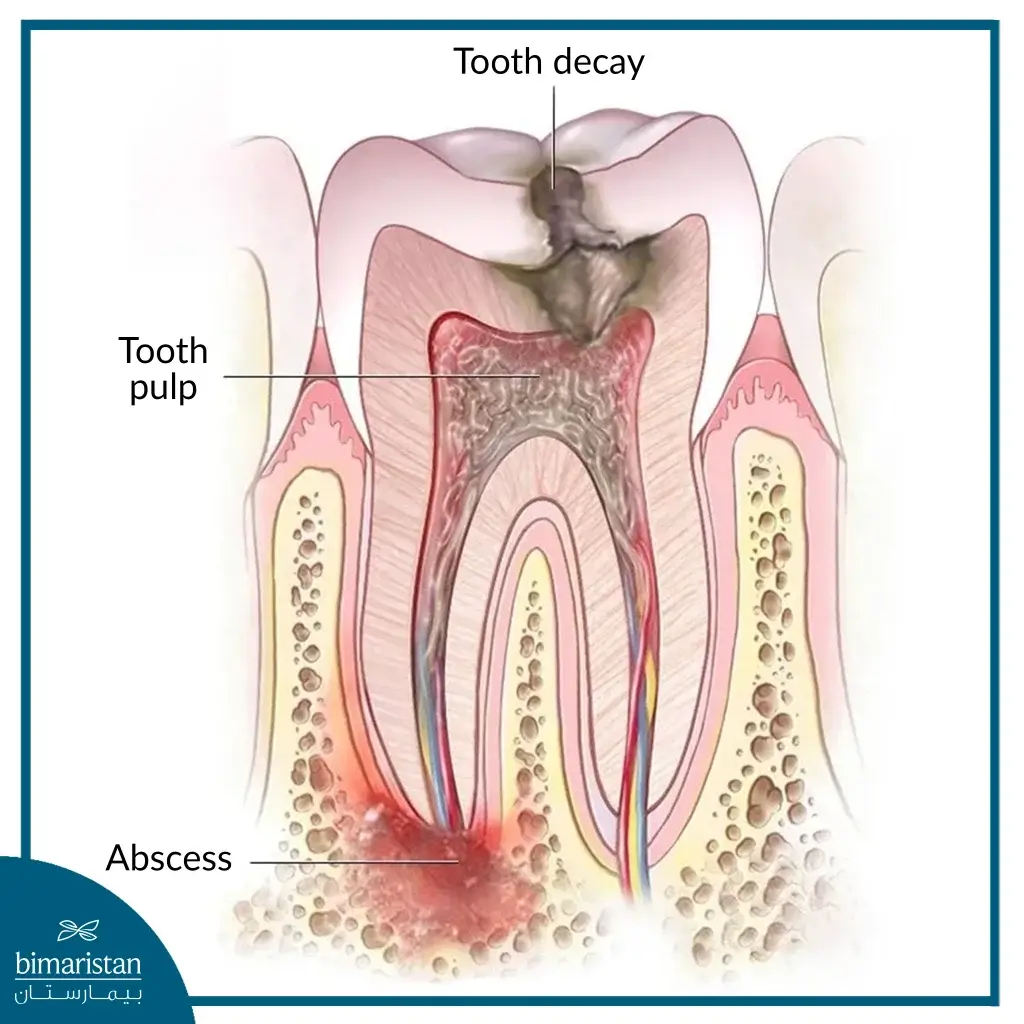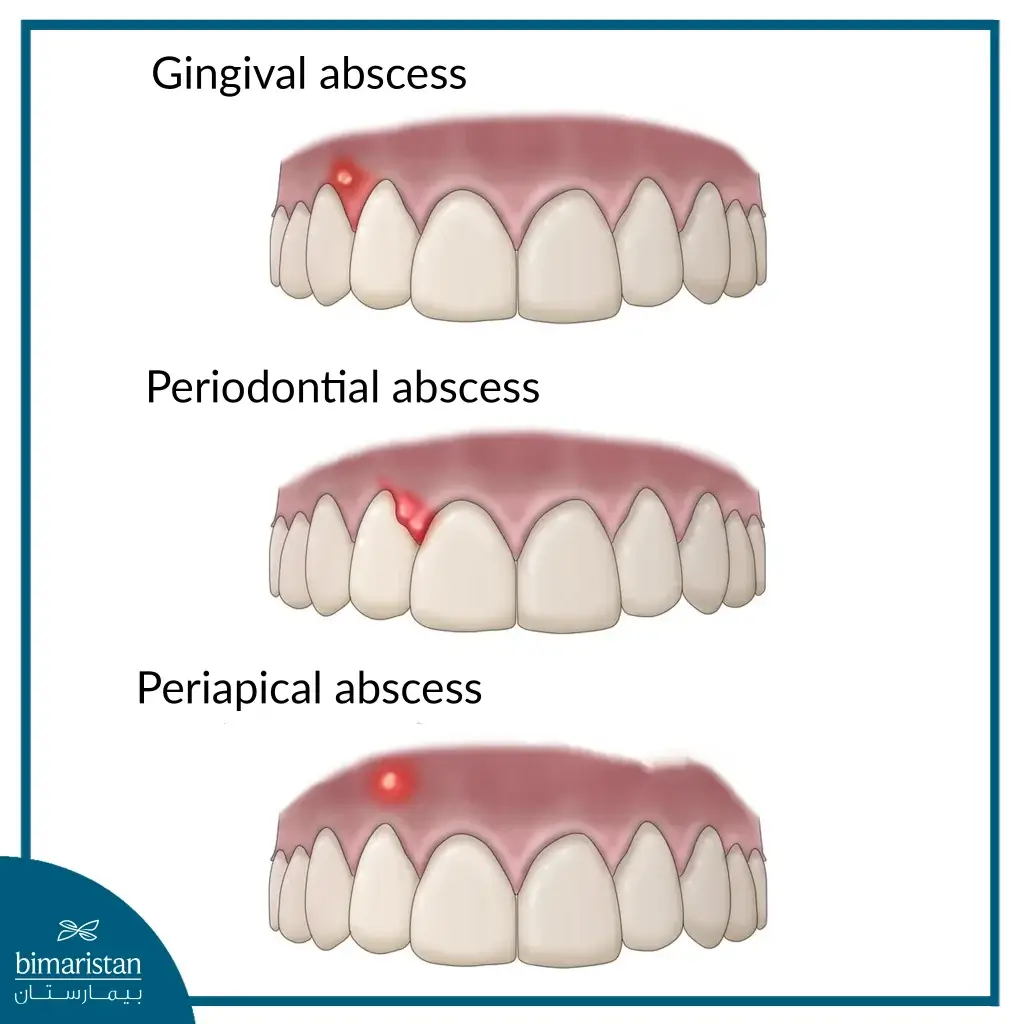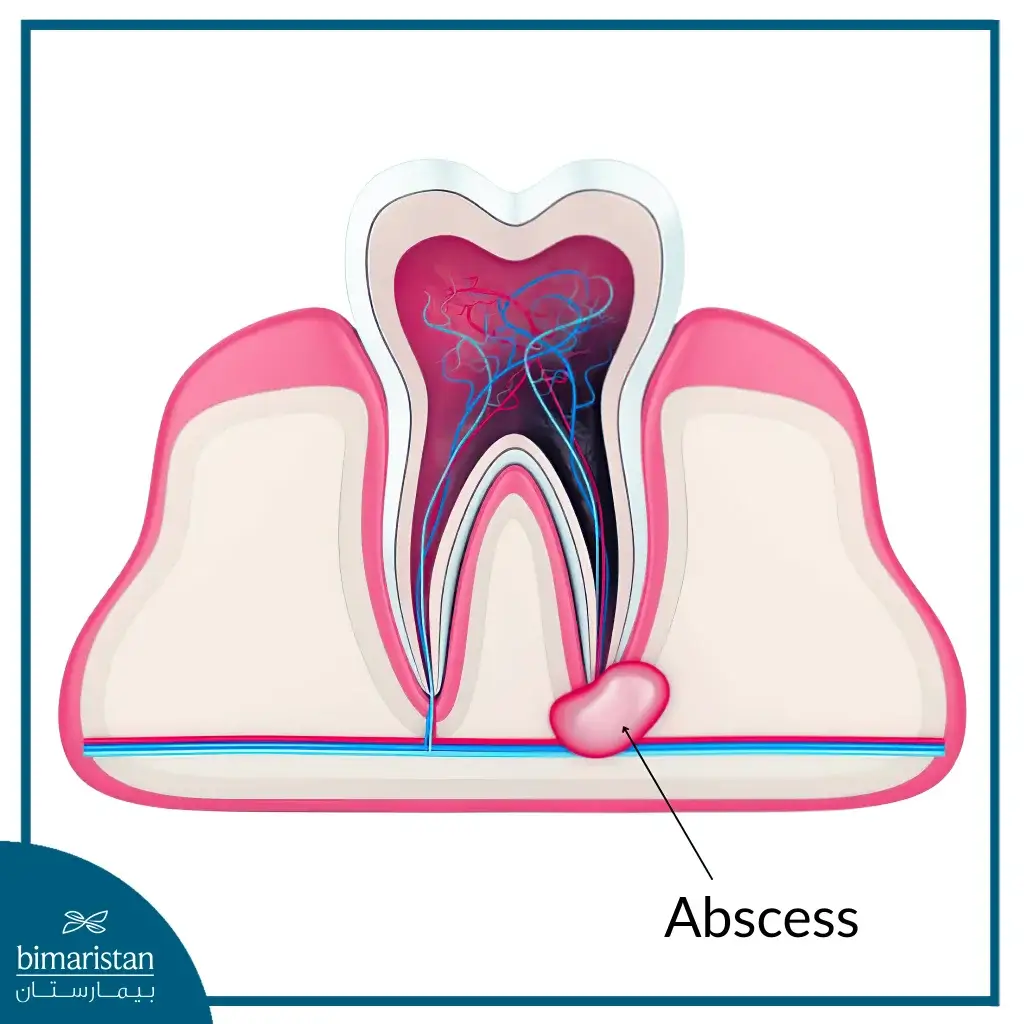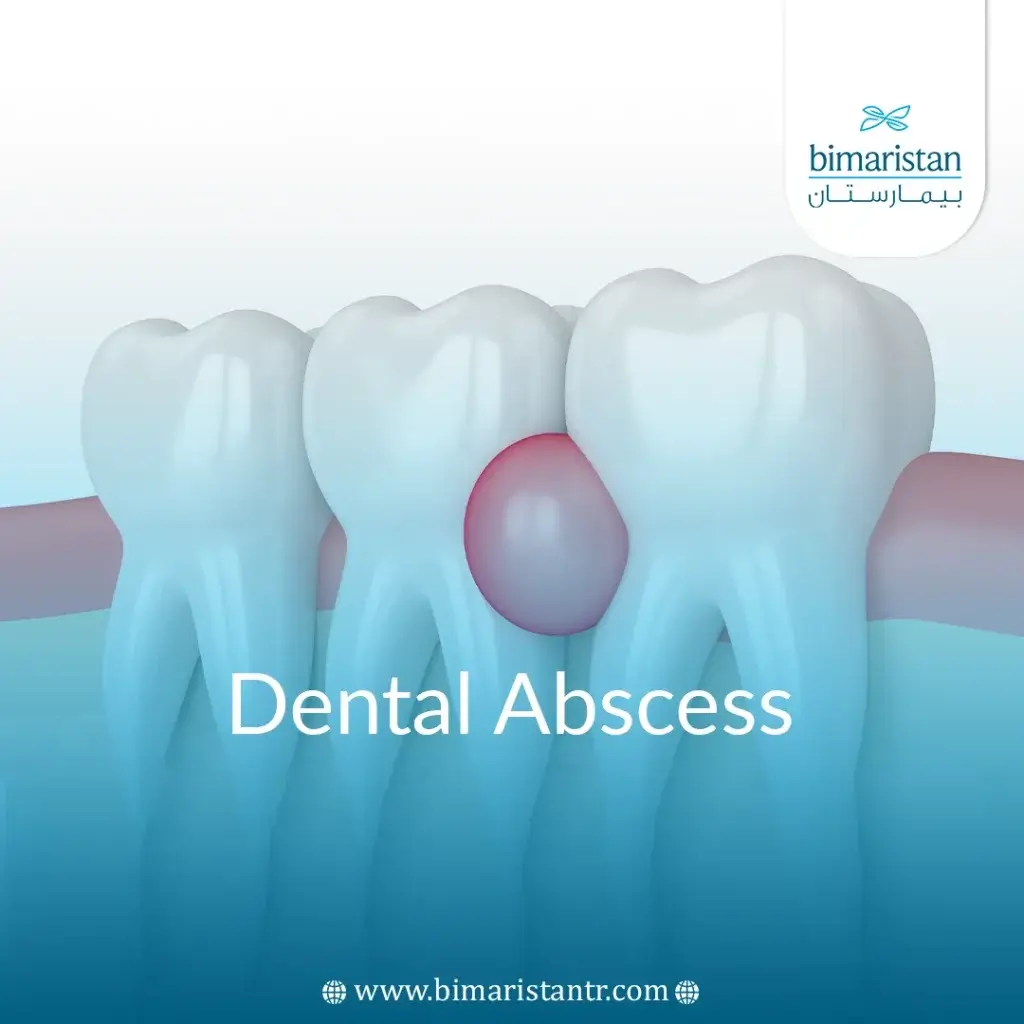A dental abscess is an accumulation of pus that forms inside the teeth or gums. An abscess is usually the result of a bacterial infection that often accumulates in the dental pulp.
Plaque is a buildup of food, saliva, and bacteria in the mouth that sticks to the teeth and damages the teeth and gums. If the plaque is not removed by regular and proper brushing and flossing, the bacteria may spread into the soft tissues of the teeth and gums, which may eventually lead to an abscess.

Symptoms of a dental abscess
Signs and symptoms of a dental abscess include:
- Pain in the area affected by the bite or when the area is touched
- Sensitivity to cold or hot foods and liquids
- Bad taste in the mouth
- fever
- General malaise
- Difficulty opening the mouth
- Difficulty swallowing
- insomnia
The main symptom of a dental abscess is pain, which can be pulsating and is often severe.
The pain usually starts suddenly and becomes more severe over the following hours or days, in some cases the pain may spread to the ear, jawbone, and neck.
Types of dental abscess
There are three types of dental abscesses:
- Gum abscess: An abscess forms only in the gum tissue and does not affect the tooth or gum ligament.
- Periapical abscess: This abscess begins in the pulp of the tooth.
- Periapical abscess: This abscess begins in the bone tissue that supports the teeth.
The type of abscess determines the severity of symptoms and where they are located.

Causes of a dental abscess
The mouth is an environment full of bacteria that forms a sticky film on your teeth called plaque.
If you don’t keep your teeth clean, the acids produced by the bacteria in plaque can damage your teeth and gums, leading to tooth decay or gum disease that develops into dental abscesses.
In most cases, a dental abscess is a complication of a dental infection.
Output around the peak
Bacteria enter the teeth through small holes caused by tooth decay or cavities, which form in the hard outer layer of the tooth called enamel.
Severe tooth decay eventually destroys the layer of soft tissue underneath the enamel called dentin, and if the decay continues, the hole will eventually penetrate the tooth’s inner pulpal tissue and become infected.
This is known as pulpitis. As pulpitis progresses, bacteria make their way into the bone that surrounds and supports the tooth, called the alveolar bone, and causes an abscess to form around the roots of the tooth.
Output around the tooth
When bacteria in the plaque infects the patient’s gums, they become inflamed, causing the tissues surrounding the roots of the tooth to separate from the base of the tooth and form a periodontal pocket.
The periodontal pocket is a small gap that forms when the gingival ligament separates from its attachment to the root, the pocket is easily soiled by food debris and is difficult to keep clean, so bacteria accumulates in the periodontal pocket and a periapical or periodontal abscess forms.
Patients can develop periapical abscesses as a result of certain dental procedures that may result in the accidental formation of periapical pockets.
The use of antibiotics in cases of untreated periodontitis can mask the symptoms of root abscesses that can develop into periodontal abscesses.

Sometimes, gum damage can lead to periodontal abscesses, even in the absence of periodontitis.
Can a dental abscess be treated at home?
There are procedures you can do at home to relieve the pain:
- Avoid foods and drinks that are too hot or too cold
- Chewing on the side of the mouth that doesn’t have an abscess will be less painful
- Do not use dental floss around the affected area
- Use a very soft toothbrush
But remember that home remedies can only help make a person more comfortable while waiting for treatment and not get rid of the dental abscess, as the patient must visit the dental clinic for proper treatment to avoid any complications of the dental abscess.
Complications of a dental abscess
In the vast majority of cases, complications only occur if the abscess is left untreated, although some complications can occur even after apparently effective treatment, but this is very rare.
Possible complications include:
Tooth cysts: If left untreated, an abscess can develop into a fluid-filled cavity in the area of the lower part of the tooth root, called a dental cyst.
There is a high risk of the cyst becoming infected, and if this happens, the patient will need antibiotics and possibly surgery.
Osteomyelitis: Bacteria in the abscess enter the bloodstream and infect the bones with sepsis, the patient will experience a high body temperature, severe pain in the affected bones, and possibly nausea.
The affected bone is usually near the site of the abscess and sometimes it may spread into the bloodstream and infect any other bone in the body, treatment includes either oral or intravenous antibiotics.
Cavernous sinus thrombosis: The spread of bacteria causes a blood clot to form in the cavernous sinus, a large vein at the base of the brain. Cavernous sinus thrombosis is treated with antibiotics and sometimes surgery to drain the sinus.
In some cases, the condition can be fatal and is a very rare complication.
Ludwig’s angina: It is an infection that affects the floor of the mouth when bacteria spreads from dental abscesses, swelling and severe pain appears under the tongue and neck and in severe cases the patient may find it difficult to breathe, so Ludwig’s angina is considered a life-threatening condition.
Patients are treated with antibiotics and people with acute Ludwig’s angina may need a procedure to open the airway if there are breathing issues.
Sinusitis: Occurs when bacteria spread in the small spaces behind the cheekbones called the maxillary sinuses, this condition is not serious but can be painful as the patient may develop a fever and the cheek becomes sensitive to pressure.
Sometimes the inflammation goes away on its own, and depending on the severity of the infection, your doctor may prescribe antibiotics.
Learn about the latest dental implants in Turkey
Managing pain caused by a dental abscess
Over-the-counter painkillers may help reduce pain while a person waits for treatment, it is important to follow the information on the package carefully and remember that painkillers are only there to relieve pain and cannot replace a visit to the dentist.
Aspirin, ibuprofen or Tylenol (paracetamol) are effective painkillers, however, some are not suitable for certain types of patients:
Ibuprofen and asthma: If you have asthma, do not take ibuprofen.
Ibuprofen and stomach ulcers: Do not take ibuprofen if you currently have or have ever had a stomach ulcer.
Aspirin and children: Do not give aspirin to children under 16 years of age.
Aspirin, pregnancy and lactation: Do not take aspirin if you are pregnant or breastfeeding.
Antibiotics
Antibiotics can be prescribed to prevent the spread of infection and can be taken with painkillers, such as amoxicillin or metronidazole.
Under no circumstances should antibiotics be considered as a way to dispense with or postpone treatment at the dentist.
Denatl abscess treatment in Turkey
Anyone experiencing symptoms associated with a dental abscess should see a dentist immediately, a dental abscess is easily diagnosed by a qualified dentist.
People with swallowing and breathing issues should also head straight to the emergency department of the nearest hospital.
If you can’t visit your dentist right away, visit your family doctor. A dentist cannot treat an abscess but may prescribe medications, give advice on self-care and pain management, and is also likely to know the fastest way to get emergency treatment if needed.
Incision
To open the abscess and drain the pus containing the bacteria, the doctor will administer a local anesthetic.
Treatment of periareolar abscess
A root canal treatment will be used to remove the abscess, a hole is drilled into the dead tooth so that the pus comes out while removing any damaged tissue from the nerve, then a root canal filling is inserted into the canal space in the root to prevent subsequent infections.
Processing abscess around the tooth
The abscess is drained, the periodontal pocket is cleaned, and then the root surfaces of the tooth are smoothed by scaling and debridement below the gum line, this will help the tooth to heal and prevent further infections.
Surgery
People with periapical abscesses and recurrent infections may need to have the diseased tissue surgically removed, and those with periapical abscesses and recurrent infections may have to remodel the gum tissue and remove the gum pocket
If the dental abscess reappears even after surgery, the tooth may be extracted permanently.
Sources:
